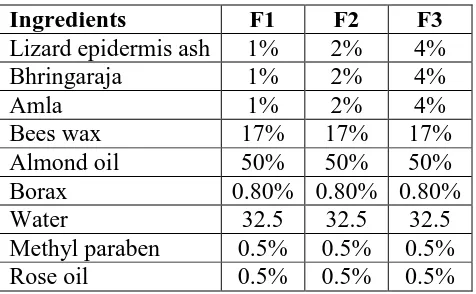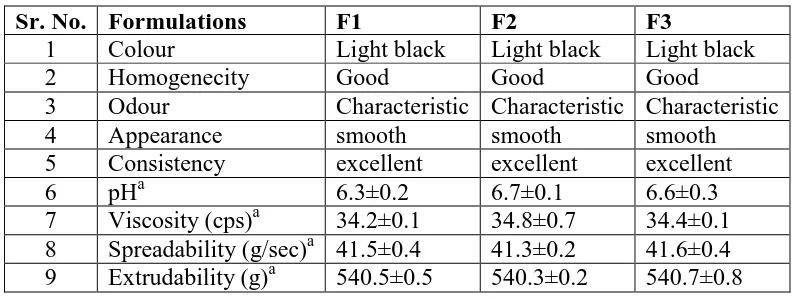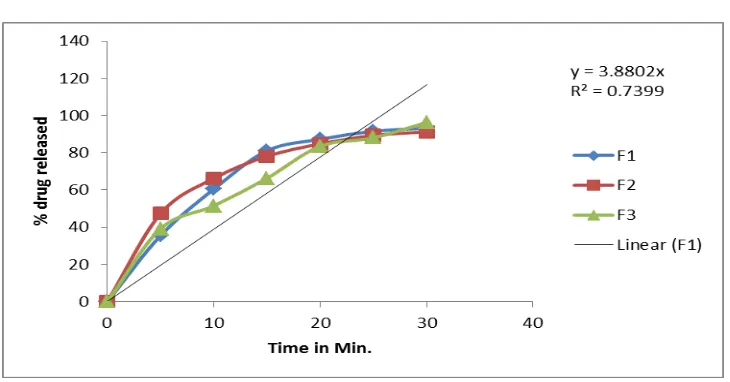FORMULATION AND EVALUATION OF CREAM FOR HAIR LOSS
Vaishnavi Mugle,Wajid Chaus* andNaresh Halke
Dayanand College of Pharmacy, Latur MS.
ABSTRACT
Manuscript describe producing keratin hair growth cream The aim of
present research was to formulate and evaluate the hair growth cream
of lizard ash it contains the keratin protein. Three different types of
cream formulations containing lizard ash in varying concentration
ranging from one percent to four percent were prepared and evaluated.
The evaluation of all the formulation [F1-F3] were done on various
parameters like physical appearance, pH, viscosity, spredability,
among the three formulation F3 showed good spredability,
consistency, homogeneity, appearance optimum viscosity, pH and
stable for long periods of time.
KEYWORDS: Keratin, protein, lizard ash, hair cream.
INTRODUCTION
Hair is one of the important part of our body and it influence over all appearance of person.
Hair plays an important role in making look younger or old and also plays an important role
in the personality of humans. Cosmetics are the preparations used to enhance the human gene
in epidermis. In alopecia loss of hair is takes place. Lizards epidermis proteins has ability to
re grow the human hair. Epidermises gives the amino acids, protein to the scalp of hair these
improve or fast hair growth.[1-2] Bhringraja help to promote hair growth and amla is hair
tonic it is rich source of vitamin C and polyphenol.
Hair loss
Hair loss is the major issue in our life. Hair loss is thinning of hair. Alopecia is a temporary
or permanent hair loss disorder. In alopecia thinning of hair on scalp is take place.
Androgenic alopecia means the combination of hormones (androgen are male hormone) and
Volume 8, Issue 6, 625-632. Research Article ISSN 2277– 7105
Article Received on 07 March 2019,
Revised on 28 March 2019, Accepted on 18 April 2019,
DOI: 10.20959/wjpr20196-14755
*Corresponding Author Dr. Wajid Chaus Dayanand College of
Pharmacy, Latur MS.
heredity (genetics). Other type of hair loss is alopecia areata (patches of baldness that usually
grow back). Telogen effluvium and traction alopecia.
Causes of hair loss
Hair loss is most convenient problem of our day today life. Hair loss has number of problems.
Scientist consider as hormone is the major cause of hair loss. In male testosterone hormone is
closely related with heredity. The man has inherited gene for hair loss, testosterone is formed
by some of the roots into derivatives called dihydrotestosterone which is responsible for hair
loss dihydrogenatione is present in the surface of sebum of hereditably predisposed people.
Other reason for hair loss is poor blood flow to the scalp.[3]
Stress
Stress also cause of hair loss in people. It occurs three month after stressful event is occurred
it take three months to hair growth start. Most of the time, it is temporary condition if people
to predisposed to alopecia.[4]
Types of hair loss
1. Androgenetic or androgenic alopecia (baldness)
Androgenic alopecia is the major cause of hair loss in men. It is hereditary baldness in
androgenic alopecia. follical size is reduced and duration of anagen is diminished increase
number of telogen.[5]
2. Alopecia areata
In alopecia areata the small circular coin size patches of scalp. The blandness that usually
grow back within month.[6]
3. Telogen effluvium
Telogen effluvium is a form of temporary hair loss that usually happens after stress.[7]
4. Chemotherapy-induced alopecia
[image:3.595.180.418.527.674.2]
Alopesia hair loss
Fig. 01: Alopecia and hair loss.
MATERIALS AND METHODS
lizard ash were produced from the lizard epidemis cell culture technology method.[8-9] bees
wax, almond oil, methyl paraben, amla and bhringaraja procured from SD fine chemical
Mumbai India and all other chemicals and reagent used were of either analytical or laboratory
grade.
Procedure
Melt the bees wax and mineral oil (almond oil) together and bring to a temp to 700c. Dissolve
borax in water and bring the temp of this solution to 700c. Add water phase to oil phase with
rapid stirring. Add lizard ash, amla and Bhringaraja in above mixture After the addition of
water, agitated slowly while cooling. Add the perfume and preservative at the temp at 500c.
Fill into the jars when cream has cooled to 420c.[10-11]
Table 01: Formulation of cream.
Ingredients F1 F2 F3
Lizard epidermis ash 1% 2% 4%
Bhringaraja 1% 2% 4%
Amla 1% 2% 4%
Bees wax 17% 17% 17%
Almond oil 50% 50% 50%
Borax 0.80% 0.80% 0.80%
Water 32.5 32.5 32.5
Methyl paraben 0.5% 0.5% 0.5%
Rose oil 0.5% 0.5% 0.5%
Evaluation of herbal hair cream formulations
Physical appearance[12]
The physical appearance was visually checked for the appearance, colour and the feel on
application of prepared hair cream formulations. Results are as shown in table 2.
Homogeneity[13]
After the cream formulations have been set in the container, all developed gels were tested
for homogeneity by visual inspection. They were tested for their appearance and presence of
any lumps, flocculates or aggregates.
pH determination[14]
The pH of all hair cream formulations were determined by using the Digital pH meter. One
gram of cream was dissolved in 100 ml distilled water and stored for two hours. Electrodes
were completely dipped into the hair cream formulations and pH was noted. The
measurement of pH of each formulation was done in triplicate and average values were
calculated. The results are presented in table 2.
Extrudability determination[15]
The hair cream formulations were filled into collapsible metal tubes. The tubes were pressed
into extrude the material and extrudability of the formulations was checked. The extrudability
of the formulations was determined in terms of weight in grams required to extrude a 0.5 cm
ribbon of cream in 10 seconds. The comparative extrudability of the hair cream formulations
is as shown in table 2.
Viscosity determination
Brookfield viscometer was used to determine viscosity. Sufficient quantity of cream was
filled in wide mouth jar separately. The height of the cream in the jar should be sufficient to
allow to dip the spindly. The rpm of the spindle was adjusted to 2.5 rpm. The viscosities of
Table 2: Evaluation Study of prepared cream formulations.
Sr. No. Formulations F1 F2 F3
1 Colour Light black Light black Light black
2 Homogenecity
No lumps,
flocculates or aggregate
No lumps,
flocculates or aggregates
No lumps,
flocculates or aggregate.
3 Odour Characteristic Characteristic Characteristic
4 Physical Appearance smooth smooth smooth
5 Consistency good good good
6 pHa 6.2±0.2 6.3±0.1 6.1±0.3
7 Viscosity (cps) a 33.2±0.1 31.8±0.3 30.3±0.6
8 Spreadability (g/sec) a 43.5±0.2 42.4±0.9 41.3±0.8
9 Extrudability (g) a 530.5±0.2 5390.3±0.2 543.7±0.8
Stability studies[16]
All the formulations were equally good with respect to appearance, homogeneity, pH,
viscosity and extrudability. So F3 was selected for stability studies. The stability studies were
carried out for all the prepared cream formulations at room temperature and humidity at
75RH. The stability study was conducted for the period of 3 months. The parameters like
appearance, pH, extrudability, colour were tested every month. The results are tabulated in
table 3.
Table 3: Stability Study of prepared formulations for one month (30days).
Sr. No. Formulations F1 F2 F3
1 Colour Light black Light black Light black
2 Homogenecity Good Good Good
3 Odour Characteristic Characteristic Characteristic
4 Appearance smooth smooth smooth
5 Consistency excellent excellent excellent
6 pHa 6.3±0.2 6.7±0.1 6.6±0.3
7 Viscosity (cps)a 34.2±0.1 34.8±0.7 34.4±0.1
8 Spreadability (g/sec)a 41.5±0.4 41.3±0.2 41.6±0.4
9 Extrudability (g)a 540.5±0.5 540.3±0.2 540.7±0.8
RESULTS AND DISCUSSION
Physical appearance The colour of all the herbal cream formulations F1, F2 and F3were
found to be pale black with translucent appearance which was found to be smooth on
application.
Homogeneity All the developed creams were tested for homogeneity by visual inspection for
appearance and presence of any lumps, flocculates or aggregates. The homogeneity was
[image:5.595.99.496.454.603.2]pH determination The pH of all the herbal cream formulations ranged between 6.1 to 6.3,
that suited the hair, indicating the compatibility of the herbal cream formulations with the
hair.
Extrudability determination All formulations showed good extrudability when extruded
from metallic collapsible tube. Comparatively F3 had excellent extrudability than F1, and F2.
Viscosity determination
The viscosity of all the formulations were found in the range of 33.30cp to 33.2 cps.
Stability study
The stability studies were conducted for all the formulations for a period of 3 months. No
appreciable changes were found for the tested parameters like appearance, pH, extrudability,
at both the temperatures (room temperature and 40 C). The results are tabulated in table 3.
7.3.7 In vitro- diffusion study[17]
In-vitro diffusion studies the in-vitro diffusion studies for all formulations (F1-F3) were
carried out using the Franz-diffusion cell. The diffusion cell apparatus was fabricated as an
open ended cylindrical tube. A weighed quantity of formulation equivalent to 1gm of the
drug was placed onto the dialysis membrane-70 (Hi- Media) and was immersed slightly in
100ml of receptor medium (phosphate buffer pH 6.8+ ethanol in ratio 40:60) which was
continuously stirred and the temperature was maintained at 37±1°C. Aliquots of 1ml were
withdrawn from each of the system at time intervals of 5, 10, 15, 20, 25 and 30 minutes were
analyzed for drug content using ultraviolet spectrophotometer. Table no.4, fig. no.02.
Table 4: In vitro- diffusion study of prepared cream.
Time F1 F2 F3
0 0 0 0
Fig. 02: % in vitro diffusion study of prepared formulations.
CONCLUSION
The formulations of hair cream provides a good base for treating the scalp and strengthens
the hair thereby preventing the hair fall. There is a further scope for pharmacological studies
in lower animals
REFERENCES
1. Identification of reptilian genes encoding hair keratin-like proteins suggests a new
scenario for the evolutionary origin of hair, 2008 Nov 25.
2. The Evolutionary Origin of Mammals' Hair Is Found in Reptile November 11, 2008.
3. Paus R. Drug discovery Today: Therapeutic strategies, 2006; 3: 101-110.
4. Botchkarev VA. Am J Pathol, 2000; 162(3): 709-12.
5. Cotsarelis G, Millar SE. Towards a molecular understanding of hair loss and its treatment.
Trends inmolecular medicine, 2001; 7(7): 293-301.
6. Rakesh K, Shukla Karunakar D, Mahajan SC, Sharma M. Formulation and evaluation of
hair oil for hair loss disorders. Journal of Medicinal Plants, 2016; 4(3): 13-7.
7. Obaidat NA, Rawashdeh BT, Wreikat AR, Awamleh AA. A potential relation between
telogen effluvium and iron deficiency in adult females. JRMS, 2005; 12(1): 62.
8. Grevelman EG, Breed WP. Prevention of chemotherapy-induced hair loss by scalp
cooling. Annals of Oncology, 2005; 16(3): 352-8.
9. Cell culture from lizard skin;a tool for the study of epidermal differentiation. polazzi E et
al .tissue cell, 2011.
10.Aswal, A, Kalra, M, and Rout, A. Preparation and evaluation of polyherbal cosmetic
11.Aditi, V, Sharma, P. Formulation and evaluation of topical anti acne formulation of
coriander extract. International Journal Pharmaceutical Sciences Reviews and Research,
2012; 16(2): 97-103.
12.Regupathi T, Chitra K, Ruckmani K, Lalitha KG and Mohan Kumar. Formulation and
Evaluation of Herbal Haircreamfor Hair Growth Potential. J Pharmacol Clinical Res.,
2017; 2(2): 1-8.
13.Ankita C and Biyani KR. Design, development and characterization of novel herbal hair
styling preparation. Int J Pharma Chem Bio Sci., 2014; 4(3): 665-672.
14.Preet Kaur, Rajeev Garg and Gupta GD. Development and evaluation of topicalcreamof
minoxidil from different polymer bases in application of alopecia. Int J Pharmacy and
Pharm Sci., 2010; 2(3): 43-47.
15.Sharma M, Bhowmick M, Pandey GK, Joshi A and Dubey B. Formulation and evaluation
of haircreamfor the treatmentof chronic inflammatory disorderseborrheic dermatitis. Int J
Pharma Res Sch., 2013; 2(1-4): 277-7873.
16.Chauhan K, Tyagi B, Singh B and Agarwal S. Accelerated stability studies of polyherbal
preparation (Ezmov) capsule, 1999; 8(3&4): 210217.
17.Supriya Agnihotri, Sharad Wakode, Anoop Agnihotri, Formulation and evaluation of
herbal antiacne gel of myrica esculenta Asian journal of pharmaceutical and clinical


